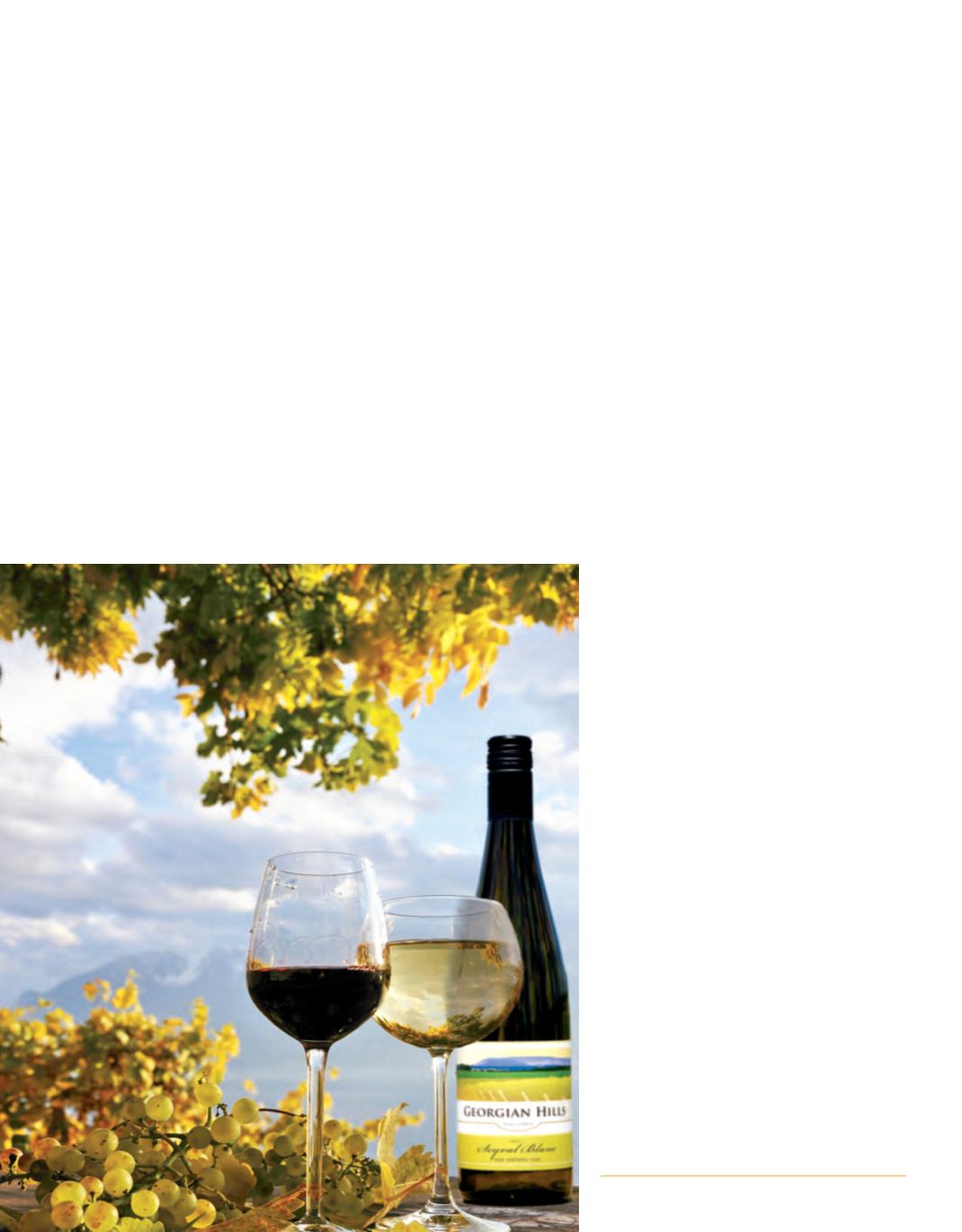
84
Escarpment Magazine Summer 2013
ESCARPMENT EPICURE
|
impeccable taste...
“This further north, they're more in their zone,” says
Robert, “and they're making great wine.”What's even
more exciting is that the grapes are varieties the con-
sumer doesn't know too much about, creating a truly
unique flavour for the region. “We might have some-
thing that we can clearly say is our style of wine.
We've got our own thing happening here.”
But even within the limited scope of Grey County wine
country, variation exists. Georgian Hills grows seyval
blanc, while Coffin Ridge has the acadie and the mar-
quette. The different grapes mean the region has two
chances to succeed, while carving out a niche in the
Ontario wine market. In addition to offering visitors a
chance to taste something that is special to the area,
Georgian Hills takes the opportunity to educate their
guests about wine appreciation. They offer cheese
and food pairings that aremeant to help people better
understand how the wine and food compliment each
other. Taking care to keep the experience local, the
cheese and foods are from the area. Similarly, Coffin
Ridge is pleased to offer a local cheese and charcu-
terie plate to its visitors.
Long before vintners were looking at Ontario as pro-
duction market, the province was benefiting from an
established beer industry. The Labatt Brewing Com-
pany Ltd. opened in London in 1847, offering healthy
competition to Molson of Montreal. Nearly one hun-
dred and forty years later, in 1984, Ontario enjoyed
a kind of beer renaissance with the opening of the
Brick Brewing Company of Waterloo. It was the
province's first craft brewery, and its success helped
pave the way for more independent breweries. In
2005, several independents formed theOntarioCraft
Brewers with the goal of promoting local beer, and
soon after the Ontario Microbrewery Strategy was
created by the province to help brewers explore mar-
keting, training, and tourism development.
Dissimilar to the regulated appellation system that or-
ganizes the Ontario wine landscape, the province's
beer landscape is viewed as loose collection of craft
breweries. Since beer ingredients can be either local
or imported, there's no sense of terroir, at least not the
way that it applies towine production. Beer marketing
does not rely on origins or regional variations in style
and taste, so craft brewers must find other ways to
identify themselves to their consumers.
As craft beers become more available, awareness
and demand grow in turn. At present, there are over
thirty-five licenced craft brewers in Ontario produc-
ing high-quality beer. These brewers are supplying
a growing market for local alternatives to main-
stream products, and each craft beer reflects the
brewers' unique interpretations and brewing styles.
Regulations placed on grapes can hinder the growth of a new wine region. “We're trying
a lot of grapes that are not on the VQA list,” says Mike. If they were forced to plant only
those grapes on the list, the vineyard would fail. “They're inferior grapes for this region, so
we don't plant them.” But experimentation sometimes results in marginalization. “There are
a lot of tax incentives to plant [the VQA] varieties, so it really is an uphill battle.” The rewards
are worth it. “We were the first non-VQA wine that Vintages bought from an Ontario win-
ery, so we're breaking ground in that respect and making it easier for other wineries.”
Traditionally, therewas a lot of pressure onGrey County to produce apples and to compete
in theworld applemarket. This pressure eventually developed into a niche or speciality agri-
culture that produces Gala and Red Prince apples. But there was still room for something
else. “I thought that growing grapes and making good wine made sense,” says Robert
Ketchin. “It was just a matter of which grapes and where in the valley they could grow.”
The Beaver Valley enjoys a micro climate between the escarpment and the lake that can
support viticulture. Again, it took a fair bit of experimentation before the right grapes were
found. “We had know that we were planing varieties that would survive our winter and
could ripen in a short window.” It's the same challenge that facedNeil when he first began
planting grapes for what would become Coffin Ridge. “There are purists who think you
can only grow the European types, but the grapes don't like -25 degrees. When you get
a cold winter, you have to depend on the hybrids.”
Georgian Hills grows French-American hybrids that were developed in the Alsace region
of France. The grapes have been grown inOntario for decades, but were used to produce
bulk wine. It took an enterprising mind to crop down the grapes and give them a chance
to make better wine.
{
We've
got our
own thing
happening
here.


